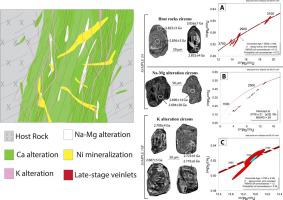当前位置:
X-MOL 学术
›
Ore Geol. Rev.
›
论文详情
Our official English website, www.x-mol.net, welcomes your feedback! (Note: you will need to create a separate account there.)
The Neoarchean GT-34 Ni deposit, Carajás Mineral Province, Brazil: an atypical IOCG-related Ni sulfide mineralization
Ore Geology Reviews ( IF 3.3 ) Pub Date : 2020-12-01 , DOI: 10.1016/j.oregeorev.2020.103773 Victor B. Garcia , Maria Emilia Schutesky , Claudinei G. Oliveira , Martin J. Whitehouse , Sergio R.B. Huhn , Claudia T. Augustin
Ore Geology Reviews ( IF 3.3 ) Pub Date : 2020-12-01 , DOI: 10.1016/j.oregeorev.2020.103773 Victor B. Garcia , Maria Emilia Schutesky , Claudinei G. Oliveira , Martin J. Whitehouse , Sergio R.B. Huhn , Claudia T. Augustin

|
Abstract The GT-34 deposit, located 12 km to the SW of the Sossego copper-gold mine in the Carajas Province, northern Brazil, represents an unusual Ni sulfide mineralization. The deposit occurs along a NE-SW-trending sub-vertical shear zone marked by progressive Mg-alkalic alteration zones, predominantly hosted in granitic and locally in granodioritic to tonalitic orthogneisses. Initial alteration zones result in unique scapolite-orthopyroxene assemblage, which is partially preserved within pervasive hornblende-chlorapatite ± plagioclase replacement zones. Nickel mineralization occurs mainly as matrix-supported breccias characterized by a pentlandite-pyrrhotite-rich matrix and rounded fragments chiefly of hornblende and chlorapatite. Irregular stockworks and net textured veins containing chalcopyrite-pentlandite are less common. Phlogopite ± talc ± actinolite alteration and late-stage veinlets crosscut the previous alteration zones and the mineralization. The phlogopite ± talc ± actinolite alteration occurs as irregular veins and chalcopyrite-pyrrhotite-magnetite are commonly observed where such alteration intersects the Ni mineralization. Late-stage veinlets are represented by K feldspar-epidote-chlorite-calcite and quartz-albite-chlorite-calcite-epidote veins, both containing minor amounts of millerite, pyrite and F-OH-apatite. High-resolution SIMS U-Pb zircon geochronology obtained for the GT-34 deposit revealed an age of 2828 ± 4 Ma for zircon grains inherited from the host orthogneisses. The timing of the mineralization altered zircon grains from the scapolite-orthopyroxene and phlogopite ± talc ± actinolite alteration zones, is attributed to an age interval between 2751 and 2720 Ma. Although poorly constrained, the geochronological data corroborate a Neoarchean age for the GT-34 Ni mineralization, similar to that of other IOCG deposits in the Carajas Province and coeval with the bimodal magmatism in the area. The atypical orthopyroxene-marialite mineral chemistry support a metasomatic crystallization at high temperatures (>700°C), low aH2O (
中文翻译:

巴西 Carajás 矿产省的 Neoarchean GT-34 Ni 矿床:非典型 IOCG 相关的硫化镍矿化
摘要 GT-34 矿床位于巴西北部卡拉哈斯省 Sossego 铜金矿西南 12 公里处,代表了一种不寻常的硫化镍矿化。矿床沿以渐进的镁碱蚀变带为标志的 NE-SW 向亚垂直剪切带分布,主要赋存于花岗岩中,局部分布在花岗闪长岩至斜方麻岩中。最初的蚀变带导致独特的方柱石-斜方辉石组合,部分保留在普遍存在的角闪石-氯磷灰石±斜长石置换带内。镍矿化主要以基质支撑的角砾岩的形式出现,其特征是富含镍黄铁矿的基质和主要为角闪石和氯磷灰石的圆形碎片。含有黄铜矿-戊兰铁矿的不规则织构和网状纹理脉不太常见。金云母 ± 滑石 ± 阳起石蚀变和晚期细脉横切先前蚀变带和矿化。金云母 ± 滑石 ± 阳起石蚀变以不规则矿脉的形式出现,通常观察到黄铜矿-磁黄铁矿-磁铁矿,这种蚀变与镍矿化相交。晚期细脉以钾长石-绿帘石-绿泥石-方解石和石英-钠长石-绿泥石-方解石-绿帘石脉为代表,两者均含有少量的闪锌矿、黄铁矿和F-OH-磷灰石。为 GT-34 矿床获得的高分辨率 SIMS U-Pb 锆石年代学显示,从寄主正方麻岩中继承的锆石颗粒的年龄为 2828 ± 4 Ma。来自方柱石-斜方辉石和金云母±滑石±阳起石蚀变带的成矿时间改变了锆石颗粒,归因于 2751 至 2720 Ma 之间的年龄间隔。尽管约束很差,但地质年代学数据证实了 GT-34 Ni 矿化的新太古代时代,类似于 Carajas 省其他 IOCG 矿床的年代,并与该地区的双峰岩浆作用同时期。非典型的斜方辉石-海长石矿物化学支持在高温 (>700°C)、低 aH2O (
更新日期:2020-12-01
中文翻译:

巴西 Carajás 矿产省的 Neoarchean GT-34 Ni 矿床:非典型 IOCG 相关的硫化镍矿化
摘要 GT-34 矿床位于巴西北部卡拉哈斯省 Sossego 铜金矿西南 12 公里处,代表了一种不寻常的硫化镍矿化。矿床沿以渐进的镁碱蚀变带为标志的 NE-SW 向亚垂直剪切带分布,主要赋存于花岗岩中,局部分布在花岗闪长岩至斜方麻岩中。最初的蚀变带导致独特的方柱石-斜方辉石组合,部分保留在普遍存在的角闪石-氯磷灰石±斜长石置换带内。镍矿化主要以基质支撑的角砾岩的形式出现,其特征是富含镍黄铁矿的基质和主要为角闪石和氯磷灰石的圆形碎片。含有黄铜矿-戊兰铁矿的不规则织构和网状纹理脉不太常见。金云母 ± 滑石 ± 阳起石蚀变和晚期细脉横切先前蚀变带和矿化。金云母 ± 滑石 ± 阳起石蚀变以不规则矿脉的形式出现,通常观察到黄铜矿-磁黄铁矿-磁铁矿,这种蚀变与镍矿化相交。晚期细脉以钾长石-绿帘石-绿泥石-方解石和石英-钠长石-绿泥石-方解石-绿帘石脉为代表,两者均含有少量的闪锌矿、黄铁矿和F-OH-磷灰石。为 GT-34 矿床获得的高分辨率 SIMS U-Pb 锆石年代学显示,从寄主正方麻岩中继承的锆石颗粒的年龄为 2828 ± 4 Ma。来自方柱石-斜方辉石和金云母±滑石±阳起石蚀变带的成矿时间改变了锆石颗粒,归因于 2751 至 2720 Ma 之间的年龄间隔。尽管约束很差,但地质年代学数据证实了 GT-34 Ni 矿化的新太古代时代,类似于 Carajas 省其他 IOCG 矿床的年代,并与该地区的双峰岩浆作用同时期。非典型的斜方辉石-海长石矿物化学支持在高温 (>700°C)、低 aH2O (


























 京公网安备 11010802027423号
京公网安备 11010802027423号